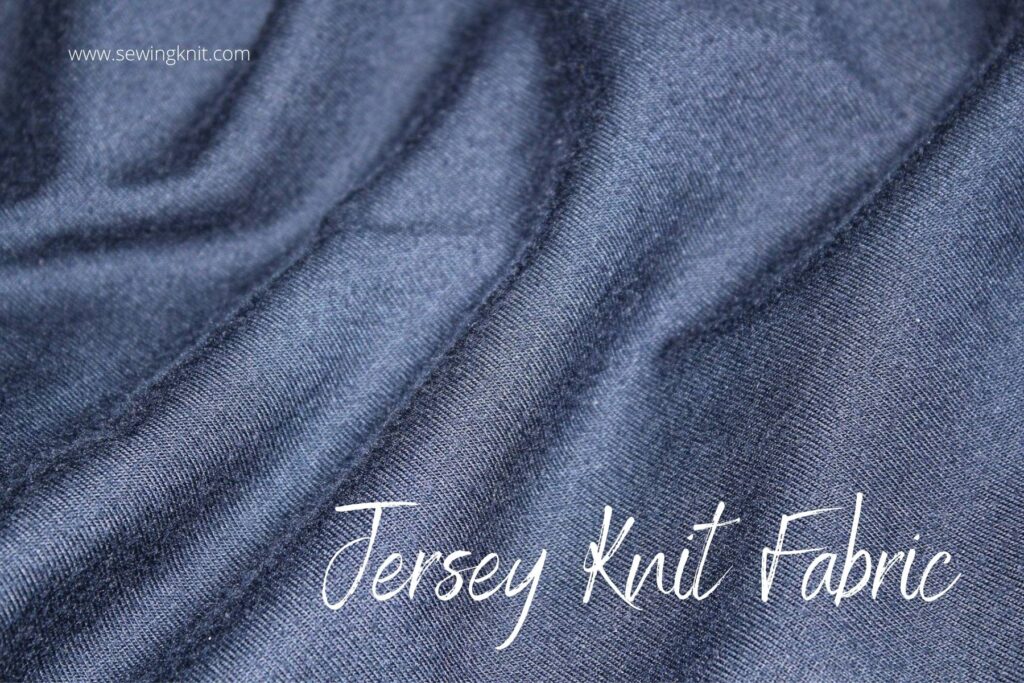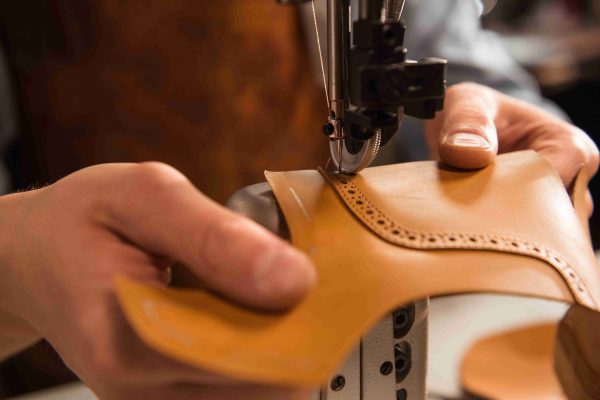
Wool was used to making jersey knit fabric in the past. This material, specifically the single knitting fabric, was delicate and had a little elasticity to it. Jersey knit fabric is now available in cotton, silk, and synthetic fibers. Double knitting cloth is less stretchy and heavier than single knitting.
The term Jersey comes from the fact that it was initially manufactured in Jersey during the Middle Ages. Undergarments and fisherman’s sweaters were made from cloth, which was thought to be exclusively for men’s wear.
Nonetheless, in 1916, the jersey market exploded, and the fabric was quickly adopted by the women’s design industry, resulting in pleasant outfits and jackets.
What is jersey knit?
Jersey is a stretchy, silky cotton fabric with a single-knit construction. Jersey has inbuilt flexibility without the addition of stretchy fibers like elastane due to the obvious way it is woven.
Jersey is the material that is used to manufacture your beloved cotton sweatshirt, but did you realize that it is also used to make bedding and sheets?
Jersey sheets are more flexible, softer, and wrinkle-resistant than percale, and another common cotton used to manufacture bedding.
Jersey Comes in Two Varieties
Jersey is a knitted fabric rather than a woven one. As a consequence, the jersey has greater give and elasticity. Based on the knit technique, there are two major varieties of jersey fabric:
- A basic jersey: This is also known as single knit or plain knit since it is knitted with only one pair of needles and has a clean one side and a heaped one.
- Jersey with a double-knit construction: This is two pieces of single-knit jersey stitched together to provide a flat finish on both sides, also known as interlock jersey.
Jersey Knit Fabric Attributes
The variety of fibers used to produce the knit fabric determines its properties. Cotton differs from silk and wool in several ways. However, there are several characteristics that all jersey knit fabrics have in common.
Resilience
Jersey knit fabric is long-lasting and tear-resistant. It lasts a long time, and maybe machine washed and ironed. After wrinkling, it retrieves its form and resumes to its previous shape.
Flexibility
This is dependent on the knit and fiber used in the cloth. The single knitted fabric has a higher degree of elasticity. The majority of jersey knit textiles are quite soft to the touch.
Draping
Thinner jersey knits may be draped with ease. They also have a proclivity for curling around the margins. Jersey knits with higher weight are more secure.
Versatility
Jersey knit textiles can be used to produce underwear, t-shirts, flannels, waistcoats, jackets, and gowns, according to the fibers chosen.
Jersey Fabric Uses
- Jersey is among the most widely used, adaptable, and versatile fabrics worldwide. T-shirts and tank tops are two of the most popular products produced from jerseys.
- Knit fabrics, such as jerseys, are used to make most t-shirts because they are opaque, flexible, and permeable, making them ideal for relaxation and functional uses.
- Jersey fabric is used to manufacture sweatpants and sweatshirts because of its elasticity, warmth, and porosity, making it ideal for resting.
- Jersey bed sheets are popular because of their softness and absorbency.
- Many undergarments are constructed of jersey fabric, which is ideal for this use due to its flexibility and absorbency.
- Jersey is a suitable fabric for athletic pursuits because of its flexibility and absorbency. Conversely, today’s modern sports outfits, commonly referred to as “jerseys,” are not necessarily made of jersey material—the moniker comes from the fact that they were frequently made of jersey material in the past.
Tips for Sewing with Jersey
Jersey is a wear-resistant material that can be used for a variety of projects, but if you’ve never dealt with knitted textiles before, it can be difficult to sew with. Here are several stitching recommendations for jersey fabric.
Choose a needle with a ballpoint tip. Although a sharp standard needle may be used to stitch knit materials, it is prone to causing small rips. When stitching, ensure you are using a ballpoint needle, which glides in between the strands instead of tearing them.
On your sewing machine, use a walking foot. You can sew with a standard foot, but if you’re concerned about straining the material as it passes through the needle, a walking foot will help everything flow smoothly, so your completed product doesn’t have odd stretches.
Make use of the zigzag stitch. If you merely use a straight stitch to sew your knit fabric, the cloth will stretch, but the seams will not, resulting in no give in the final result and torn sutures. When stitching, keep in mind, you use a zigzag stitch, which provides for flexibility. If you have one, you may also use a ripper to snip and complete your seams as you go.
Hems should be sewn using a twin needle. Ensure to finish your hems with a twin needle since the double straight stitch is a finer ending approach that also accommodates the fabric’s flexibility.
Finally, try it on a sample. If you’re concerned about stitching with fabric, practice on a spare piece first and get the size and give of your stitches just before going on to the piece you’re making.
Jersey Knit Fabric Types
Jersey knit textiles are made from a variety of fibers. Because they may be worn for a variety of events, they are flexible and useful.
Jersey Knit Cotton Fabrics
Cotton fibers or cotton mixes are used to make these. They’re often quite light and airy and can be very hefty. These fabrics aren’t appropriate for curtains, but they’re more durable and structured, so they’ll last longer.
Cotton jersey knits are commonly utilized in the production of children’s clothing and t-shirts because they are absorbent. Cotton jersey knits are used to produce trousers, dresses, and straight skirts due to their rigidity.
Jersey Knit Fabrics Made of Wool
Wool jersey knits are medium to hefty, making them ideal for the autumn and winter seasons. They’re warm and comforting, and they may be utilized to construct a variety of winter outfits. Because natural wool is extremely costly, people often add wool blends to make them more flexible.
Jersey Knit Fabrics in Rayon or Viscose
These fabrics are silky soft to the touch and have a great droop, making them ideal for figure-hugging gowns. The fabric gains additional stretch and recovery by mixing rayon with spandex and Lycra, making it more flexible and useful.
Jersey: How Do You Look After It?
Jersey is a very simple fabric to care for, but give heed to the fibers used in the knit fabric. Pre-wash your textiles before stitching since cotton jersey has a propensity to shrinkage. Jersey should be washed in cold water and gently dried on moderate. If you take your clothes from the dryer immediately, you won’t need an iron.
What is the environmental impact of jersey fabric?
Jersey fabric’s environmental effect depends largely on the fibers it includes. Synthetic fibers, for example, have a significant detrimental environmental impact. Polyester and rayon manufacture entails the use of toxic materials. Although these contaminants may sometimes be contained or reused, they ultimately wind up polluting the natural ecology, even if they are managed appropriately.
Every time synthetic fabrics are washed, harmful microfibers are released into the water system. Synthetic fabric is released into the environment as non-biodegradable waste after its product lifecycle. As a consequence, utilizing synthetic fibers to make jersey fabric is unhealthy for the ecosystem.
Wool and cotton, on the other end, can be friendly concerning the environment. Cotton growers frequently use hazardous agrochemicals, although it is possible to produce cotton without them because cotton is very disposable.
Frequently Asked Questions
Is jersey knit wrinkle-resistant?
Answer: Knit is a type of fabric that is composed of overlapping loops of thread. Wool yarn is typically used; however other knits, like jerseys, can be made of wool, cotton, or synthetic fibers. Knits that are bulkier (and textiles in general) are less likely to wrinkle than thinner knits. Jersey fabric does not wrinkle readily due to its inherent elasticity, which allows it to maintain its form.
Is it simple to clean jersey knit?
Answer: The jersey is made of 100% cotton and is easy to spot clean or machine wash. Odors will readily be released from cotton jerseys.
To minimize shrinking, most machines require washing jersey knit sheets in cold water. Whilst it prevents the cloth from wrinkling, it isn’t the most sanitary choice for a sheet. Warm to hot water is typically advised, particularly if you’re trying to get rid of bed bugs from your bedding.
Is it better to wear jersey fabric in the summer or the winter?
Answer: Depending on the yarn, it may be worn in the summer or the winter. Jersey is a good contender for summer clothes since it won’t weigh you down and is versatile. It’s almost always mixed with cotton to produce a tough yet breathable fabric. They are especially warm in the winter due to the thick, plush material.
Is jersey fabric made from natural fibers or synthetic fibers?
Answer: Jersey fabric is classified as synthetic if it is composed of a fiber such as polyester, natural if it is made of a natural yarn such as cotton, or man-made if it is made of an artificial yarn such as viscose.
What is the composition of jersey fabric?
Answer: Jersey is a knit fabric with a gentle elasticity that was initially created of wool. Jersey is now manufactured from a variety of materials, including cotton, cotton blends, and synthetic fibers. The top half of the jersey knit fabric has a flat finish with a single rib knit, while the reverse is heaped with knots.
Final words
Jersey has a lot of great qualities, and with a little expertise and a few pieces of equipment that you can save a lot of the hassle when sewing with it. Due to its high stretch, the jersey is tough to sew with, but with the techniques and information above, you’ll be sewing with jerseys like an expert in no time. Take the jersey out of your stockpile and start making something lovely with it right now.



This is an informative article on jersey knit fabric. I think it has good information for all people who want to know about jersey knit fabric.
Thanks for your comment